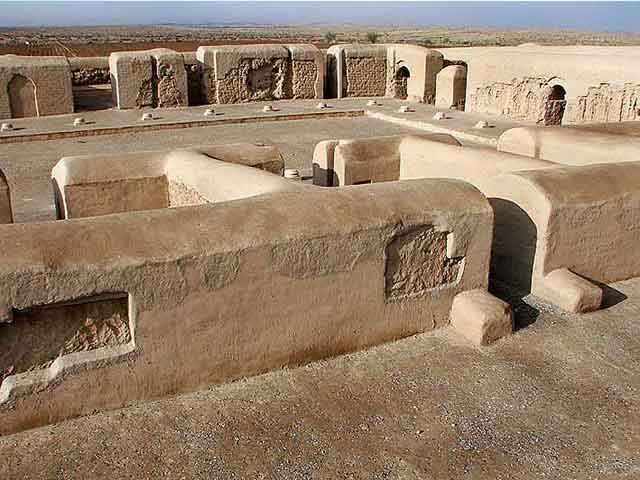Fayaztepa is a Buddhist temple complex dating back to the 1st-3rd centuries BC. This complex is located in Termez, near the north-western ruins of the old city. In 1968, Absad Beknayev in the dunes found a Buddha sculpture made of alabaster, which was later transferred to the museum of local lore. In 1968-76 this discovery was studied by L.I. Albaum.
Initially, many monuments were red, later they were covered with gold paint. On the southern part of the temple there is an image of a Buddha dressed in red robes. On both sides of the Buddha are depicted silhouettes of two people in long robes with buckles on their shoulders. One of these people is depicted at the time of Buddha worship. Also on the eastern wall of the shrine you can see the traces of once applied wall paintings. And on the clay pieces of the interior of the room are images of people of different people. On one of the clay debris, the size of which is 60 × 80 cm, an image of two men, whose faces are directed towards the Buddha, is found. On these two figures worshiping the Bactrian Buddha, one can conclude that the Buddha was an idol for worship. In this room you can find a large number of fragments of the monument, made of gypsum. Along the eastern side of the wall a special pedestal of burnt bricks is built, designed for sculptures, and the surface of this pedestal is evenly covered with fragments of stones. Most of the statues are made from a mixture of clay and straw, the outer part of which is covered with gypsum.
The heads of these statues were placed in special forms, and the arms and legs were made separately and then they were attached to the trunk of the statues. Of all the statues located at the Fayaztepa complex, the upper part of the Buddha statue made of alabaster has the greatest attraction. The collected, black hair framing a beautiful face of the Buddha, give the statue a certain charming appearance. Such decoration of the Buddha statue is the first in the Kusanid period heritage.
Opposite the door to this sacred temple was found a rare art object - a triad, created from a single piece of marble stone. In the center of the triad is a Buddha, sitting on the branches of the sacred Bodha tree, and next to him are two worshiping monks. Two coins of Kanishka and one Vasudeva were found in the temple. The courtyard of the temple has the form of a regular quadrangle measuring 33 × 20 m, where the doors of the rooms of monks are located on four sides. Inside the courtyard is a large one-piece hall, its walls are decorated with colorful drawings, which are preserved only on its lower parts. Along this hall there is a soup. In the north-western part of the courtyard is a small pond, in the form of a trapezoid, which is made of fragments of marble. At the bottom of this pond a special hole is made for water drainage. This hole is made in the form of an open mouth of a lion. The water in such ponds was clean, intended for drinking. This lion belongs to the era of Kushanid art, in its image is reflected a strong and powerful Buddha. The second part of the religious construction was a monastery, which is connected to the temple by a door leading to the courtyard. In the rooms located on the territory of the monastery, there were monks and students of the monastery, and in dormitories and offices were hostels for pilgrims. On the walls of the rooms were built special shelves, which housed lights with wicks. Along the walls of certain rooms, soups were built, intended for the establishment of statues of Buddha on them. Thus, the monks, their disciples and pilgrims prayed in the central part of the temple, when religious activities were suspended for some time



